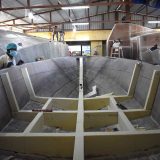India from behind the wheels

The roads of a city tell a lot about it.
Trafficology. I just made that up, but it should exist as an exalted subset of sociology or anthropology, based on the conviction that a country’s roads are windows to its soul and that no richer information can be gleaned about the temperament of a people than that which can be seen from a car window.
Take polite little England, for example: all white chevrons and traffic lights, courteous waves at roundabouts and bright green road signs. In Paris, it’s free bicycles and monumental rond-points; in Mexico City it’s endless, senseless traffic jams and gridlock; in Belgrade it’s decades-old, Communist-manufactured bangers that barely hold together over potholes and cobblestones; in Istanbul it’s a grumpy taxi driver sneaking a cigarette out of the window of his spanking new Hyundai. There’s a story on every street and a peephole into the mentality of the men and women behind the wheel and at the drawing boards of local infrastructure.
So, looking out over the sea of free-wheeling motorbikes, imposing trucks and agitated, honking buses that go together to compose the anarchic parade down Pondicherry’s MG Road, I ask myself what does India’s traffic say about her soul? That this is a nation running lawless amok? That here is a country full of pushy, impatient, beings with no decorum or spatial management skills? That the people of India have no sense of wanting to preserve their own lives or those of others and that in fact the entire country is united in one grim self-destructive death wish? It may seem so to the uninitiated eye, but in fact the road mayhem that surrounds us here can be explained in other terms entirely.I’m talking about auqaat.
In his book, Being Indian, former diplomat Pavan K Varma sets out to try and explain the complexities behind various aspects of Indian life from power to wealth and technology. And it’s among the pages of this tome that I first encountered this notion of auqaat, a word that can be translated into English as something like ‘status’. Mr Varma argues that in a country for millennia in the grip of a rigid (and functioning) hierarchical caste system, ‘the mentality of a stratified society is very much in evidence in everyday life.’
‘When two Indians meet as strangers,’ he goes on to explain, ‘the encounter is often a duel to ascertain the auqaat of the other.’ But, be warned: ‘if a person has to be asked what their auqaat is, the question is already an insult.’ Complex stuff, especially to an outsider, a foreigner and an outcaste like myself. But thanks to my little yellow Tata Nano, who I have fondly named Abhilasha, I have an in: I might be a bumbling, polite, law-abiding Britisher, but at the wheel of my car I am, for all intents and purposes, Indian. My vehicle is my avatar, my borrowed Indian identity and with it I can go undercover as an ersatz local and get hands-on experience of the meaning of road auqaat. Not only do I have the chance to witness the power play first-hand, I can also participate in it.
So here is what I have learned about the spectrum of India’s traffic hierarchy: the buses and the trucks are at the top. They can more or less do anything they want, and everyone else is obliged to give way to them. Then you have the SUVs and mini vans, followed closely by large cars. Small cars are next on the pecking order, trumping horses, cows, bullocks, carts, rickshaws, motorbikes, mopeds, bicycles, goats, pedestrians and finally dogs, whose frequent roadside carcasses attest to the sad fact that the canine race has yet to fully grasp its place on the road power pyramid.
A variation on the size rule factors in the importance of speed. A Suzuki GSX might be smaller than a rickshaw, but it’ll out-rev it in seconds; an intercity bus might command a royal presence in the fast lane, but a nifty SUV will swerve around it in a flash and leave it red-faced and spluttering in its dust. As a newcomer to India’s roads, the size + speed = aquaat equation has been a good one to use as a rule of thumb. If it’s smaller and slower, have it for breakfast; smaller but faster, use caution; larger but slower, pull a David and Goliath; larger and faster, get the hell out of the way. Easy peasy.
Consider the auto rickshaw, probably India’s best example of the way in which the manifestations of auqaat can reap massive karmic ramifications. It’s an exciting, wild, windswept way to travel, open to the elements and always dancing with danger. Yet the humble three-wheeler is also the bane of many commuters’ lives, for the simple reason that many rickshaw drivers will slip and slide their prices and general demeanour according to their assessment of their clientele, the time of day, or just their mood in general. But if you take a ride in a rickshaw, the reason for the driver’s often sharp manner might soon become apparent: like spiraling cycles of abuse in families, rickshaw drivers mistreat their customers as they themselves are vilified in turn at just about every opportunity.
A rickshaw’s auqaat is fairly low down on the power pyramid of Indian roads. There may be oodles of them about, but they are slow and small, and so are frequently overtaken, honked at and forced into sticky situations, sometimes being pushed off the road altogether. It would be hard to undergo such a great degree of butt-kicking without giving a few boots back in return.
How long her superstar status will last, however, is a good question. The end of 2010 saw Nano sales slump, something that came as quite a surprise after the initial hysteria the car’s launch ignited. I’ve heard comments from many middle-class Indians telling me they would never consider buying a Nano as, because of its price, it’s generally considered to be a poor person’s car. After all, who would want to reduce their auqaat for the sake of a car?
Gurpreet, a friend from Delhi took one look at Abhilasha and shook his head. ‘I would never buy this car,’ he said. When I asked him why, he explained that for 1-2 lakhs, you could buy a second-hand Maruti Zen or Tata Indica, or the like, on the assumption that the latter two would be far more reliable vehicles in the long run than the Nano. ‘But I’ve done over 16,000km in the Nano and it’s been fine,’ I protested, to which Gurpreet replied, ‘Yeah; let’s see how the next 16,000 go.’
Hum. Well, in any case, I’d like to think that I’d managed to jack up Abhilasha’s auqaat a few notches during the past few months, if traffic tactics and road agility count for anything. I am proud to say I have left many an Indica and Maruti Zen sprawling in my dust after a nifty overtake in the face of an oncoming lorry. I’ve swerved, dodged, accelerated through tiny gaps left between moving buses, leaving them in the sorry knowledge that maybe they aren’t the kings of the highway after all – that there is a wee orifice through which the proles and their 1-lakh cars can squeeze through.
The buses and trucks are, after all, notorious road hogs. You’ll frequently see them cruising the highways and b-roads, casually straddling two lanes (you almost imagine them carelessly whistling as they go) completely impervious to the desperate beeps of lines of cars stuck behind them. Many a time I’ve been red-faced and exasperated: ‘WHY the hell doesn’t he just move ONE meter to the left to let us though for GOD’s sake…’ etc, but the vexation is all for nothing in the end. In a world where size is key, they are the potentates, the Rajas of the Road.
I end up by taking my foot off the accelerator, exhaling, and letting the mighty ones do what they will. As Pavan Varma says, ‘the projection of power and the recognition of status are intimately related,’ meaning that people are generally happy to suck up to those more powerful than themselves, whilst in turn letting themselves be brown-nosed by upwardly mobile underlings. In road terms this means all hail the trucks, fast cars and armoured SUVs, and sucks to you cyclists and pedestrians. And dogs. Though not cows. Cows are a whole other story.
And Nanos, the exceptional Nano: middling but upwardly mobile, breaking caste barriers and irritating lorry drivers. Now, that’s my girl: a true case study for trafficology.
About the author
Vanessa Able is an English freelance writer and photographer who is currently living in Pondicherry and writing a book about her journeys around India in a Tata Nano.











